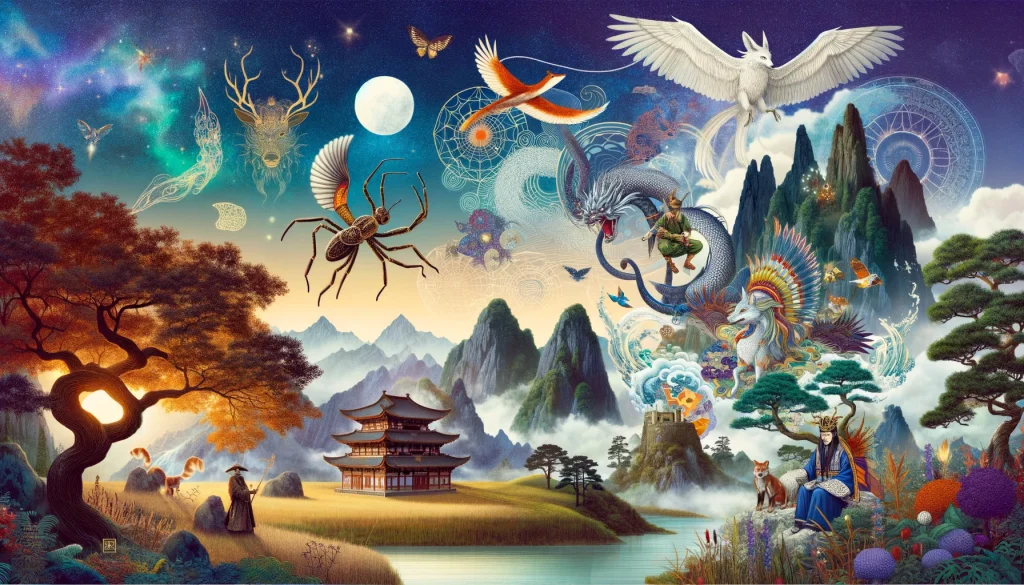
You’ve probably heard the terms “legend” or “folklore” at least once in your life. But have you ever considered what it means? In this post, we’ll explore the intriguing realm of folklore and old legends while analyzing the in-depth histories of many societies from around the world.
The Importance of Ancient Legends and Folklore
Legends and folklore are often dismissed as mere fiction or stories from a bygone era. But did you know they provide a window into understanding the cultures they originate from? They offer insight into a society’s values, fears, hopes, and historical events, serving as a cultural compass for future generations.
Understanding Legends and Folklore from Various Cultures
As we begin our exploration, it’s important to note that the context and themes of folklore can drastically vary from one culture to another. Let’s journey across continents to delve into some intriguing legends.
African Folklore
Ananasi Tales
Originating from West Africa, Anansi is a trickster spider character known for his intelligence and wit. These tales often emphasize the power of brain over brawn.
Relevance of Anansi Tales Today
The Anansi stories continue to be an integral part of African culture, teaching life lessons and providing moral guidance to children and adults alike.
Mythical Creatures in African Folklore
Africa’s folklore also boasts a plethora of mythical creatures that embody the people’s fears, desires, and their deep respect for the unknown forces of nature.
European Folklore
King Arthur and Camelot
The Arthurian Legend is one of the most enduring tales in European folklore. King Arthur, the once and future king, ruled over a golden age of chivalry and magic.
The Impact of King Arthur’s Legend
King Arthur’s stories have had an enormous impact on Western literature, influencing everything from novels to movies.
Folklore and Mythology of the Norse
Norse mythology, which originated from ancient Scandinavia, is brimming with epic tales of gods, giants, and heroes. These stories continue to inspire today’s popular culture.
Asian Folklore
Chinese Dragon Legends
Dragons are respected for their strength and intelligence in Chinese folklore and are regarded as lucky creatures. They represent both the might of the skies and the bounty of the soil.
Contemporary Influence of Dragon Legends
Chinese dragon legends continue to be an integral part of Chinese culture, influencing art, literature, and even architecture.
The Japanese Kitsune
In Japan, Kitsune or fox spirits are prominent figures in folklore. These intelligent beings are known for their magical abilities and can either bring good fortune or wreak havoc.
**Native American Legends**
The Trickster Coyote
Native American folklore often features Coyote, a trickster figure. These tales teach lessons about the dangers of selfishness and the importance of respecting nature.
Influence of Coyote Tales in Modern Native American Culture
Coyote stories remain relevant today, providing a connection to Native American cultural heritage and reminding people of the sacred relationship between humans and nature.
The Legend of the Thunderbird
The Thunderbird, a powerful supernatural being, is another prominent figure in Native American mythology. It’s often seen as a protector and a symbol of strength and courage.
Conclusion
From the trickster, Anansi in African folklore to the mighty dragons in Chinese legends, ancient tales and legends shape our understanding of various cultures. They remind us of our shared humanity and our fascination with the unknown.
The Lasting Impact of Ancient Legends and Folklore
Even in our technologically advanced society, these ancient stories continue to resonate, influencing our art, literature, and worldview. They’re not just tales; they are the whispers of our collective past, the echo of our shared human experiences.
Frequently Asked Questions
Why are ancient legends and folklore important?
Ancient legends and folklore provide valuable insights into the cultures they originate from, reflecting societal values, historical events, and human nature.
What are some of the common themes in folklore?
Morality tales, the conflict between good and evil, the value of wisdom, and the interaction between people and nature are all common topics in folklore.
How do folklore and legends influence modern culture?
Folklore influences modern culture in various ways, from literature and movies to art and music. They often serve as the basis for cultural celebrations and rituals.
Are folklore and myths the same?
While they share similarities, folklore often refers to traditions, customs, and stories passed down within a culture, whereas myths are traditional stories dealing with gods, supernatural beings, and ancestral heroes.
What’s the difference between a legend and a fairy tale?
Both sorts of folklore are considered authentic in their own cultures, but tales are frequently based on actual historical figures or events. On the other hand, fairy tales are made-up narratives that frequently contain mystical or magical elements.

I am Jeremy Jahns – Your Cinematic Explorer
Immerse in movie reviews, Hollywood insights, and behind-the-scenes stories.